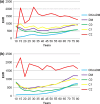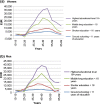Societal costs of diabetes mellitus in Denmark
- PMID: 26414087
- PMCID: PMC5061106
- DOI: 10.1111/dme.12965
Societal costs of diabetes mellitus in Denmark
Abstract
Aim: To provide comprehensive real-world evidence on societal diabetes-attributable costs in Denmark.
Methods: National register data are linked on an individual level through unique central personal registration numbers in Denmark. All patients in the Danish National Diabetes Register in 2011 (N = 318 729) were included in this study. Complication status was defined according to data from the Danish National Hospital Register. Diabetes-attributable costs were calculated as the difference between costs of patients with diabetes and the expected costs given the annual resource consumption of the diabetes-free population.
Results: Societal costs attributable to diabetes were estimated to be at least 4.27 billion EUR in 2011, corresponding to 14,349 EUR per patient-year. A twofold higher healthcare resource usage was found for patients with diabetes as compared with the diabetes-free population. Attributable costs, grouped according to different components, were 732 million EUR for primary and secondary care services, 153 million EUR for pharmaceutical drugs, 851 million EUR for nursing services, 1.77 billion EUR in lost productivity and 761 million EUR for additional costs. A steep increase in diabetes-attributable costs was found for patients with major complications compared with patients without complications across all cost components. For attributable healthcare costs this increase was estimated to be 6,992 EUR per person-year after controlling for potential confounders.
Conclusions: Nearly half of the total costs of patients with diabetes can be attributed directly to their diabetes. The majority of costs are incurred among patients with major complications pointing to the importance of secondary preventive efforts among patients with diabetes.
© 2015 The Authors. Diabetic Medicine published by John Wiley & Sons Ltd on behalf of Diabetes UK.
Figures






Comment in
-
Changing paradigms and challenges: evidence on the epidemiological and economic burden of diabetes in Latin America.Diabet Med. 2017 Jul;34(7):1009-1010. doi: 10.1111/dme.13311. Diabet Med. 2017. PMID: 28004431 No abstract available.
References
-
- World Health Organisation . Global status report on noncommunicable diseases 2010. Description of the global burden of NCDs, their risk factors and determinants. Geneva: WHO, 2011.
-
- International Diabetes Federation . IDF Diabetes Atlas Update 2012. IDF, 2012.
-
- Jansson SPO, Andersson DKG, Svärdsudd K. Prevalence and incidence rate of diabetes melitus in a Swedish community during 30 years of follow‐up. Diabetologia 2007; 50: 703–710. - PubMed
Publication types
MeSH terms
LinkOut - more resources
Full Text Sources
Other Literature Sources
Medical

